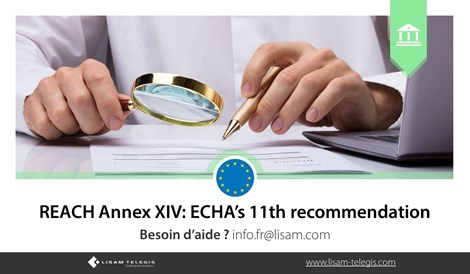REACH Annex XIV: ECHA’s 11th recommendation
REACH Annex XIV: ECHA’s 11th recommendation
vendredi 5 mai 2023
 The REACH Regulation requires ECHA to recommend to the European Commission priority substances for inclusion in Annex XIV - also known as the REACH Authorisation List - from the Candidate List. These substances are considered because of their hazardous properties for human health or the environment. To carry out this work, ECHA considers the comments received from interested parties and the opinion of the Member State Committee during a three-month public consultation. Following ECHA's recommendations, the European Commission finally decides which substances will be included in Annex XIV and what the associated entries will be. Substances not recommended in a given round are re-assessed in subsequent rounds along with the other substances on the Candidate List. They may be included in future recommendations. The aim of this process is to progressively replace the most hazardous substances with less hazardous alternatives where possible. In this context, after holding a consultation between February 2 and May 2, 2022, ECHA published on April 12, 2023 its eleventh recommendation to the European Commission requesting the addition of six substances and two groups of substances of very high concern to the REACH Authorisation list. If these substances are added to the Authorisation list, companies will have to apply for authorisation to continue using them after a date defined at the time of their inclusion in the list.
The REACH Regulation requires ECHA to recommend to the European Commission priority substances for inclusion in Annex XIV - also known as the REACH Authorisation List - from the Candidate List. These substances are considered because of their hazardous properties for human health or the environment. To carry out this work, ECHA considers the comments received from interested parties and the opinion of the Member State Committee during a three-month public consultation. Following ECHA's recommendations, the European Commission finally decides which substances will be included in Annex XIV and what the associated entries will be. Substances not recommended in a given round are re-assessed in subsequent rounds along with the other substances on the Candidate List. They may be included in future recommendations. The aim of this process is to progressively replace the most hazardous substances with less hazardous alternatives where possible. In this context, after holding a consultation between February 2 and May 2, 2022, ECHA published on April 12, 2023 its eleventh recommendation to the European Commission requesting the addition of six substances and two groups of substances of very high concern to the REACH Authorisation list. If these substances are added to the Authorisation list, companies will have to apply for authorisation to continue using them after a date defined at the time of their inclusion in the list. The substances and groups concerned are the following:
• Ethylenediamine, CAS 107-15-3, EC 203-468-6, respiratory sensitizing
• Diisohexyl phthalate, CAS 71850-09-4, EC 276-090-2, toxic for reproduction
• Lead, CAS 7439-92-1, EC 231-100-4, toxic for reproduction
• Glutural, CAS 111-30-8, EC 203-856-5, respiratory sensitizing
• 2-methyl-1-(4-methylthiophenyl)-2-morpholinopropan-1-one, CAS 71868-10-5, EC 400-600-6, toxic for reproduction
•2-benzyl-2- dimethylamino-4’-morpholinobutyrophenone, CAS 119313-12-1, EC 404-360-3, toxic for reproduction
• 2-(4-tertbutylbenzyl) propionaldehyde CAS 80-54-6, EC 201-289- and its individual stereoisomers, toxic for reproduction:
o (2S)-3-(4-tert-butylphenyl)-2-methylpropanal CAS 75166-30-2, o (2R)-3-(4-tert-butylphenyl)-2-methylpropanal CAS 75166-31-3,
• Orthoboric acid, sodium salt, CAS 13840-56-7, EC 237-560-2 and its derivatives, toxic for reproduction: o Boric acid, sodium salt, CAS 1333-73-9, EC 215-604-1
o Boric acid (H3BO3), sodium salt, hydrate, CAS 25747-83-5,
o Boric acid (H3BO3), sodium salt, 1:1, CAS 14890-53-0,
o Boric acid (H3BO3), disodium salt, CAS 22454-04-2,
o Trisodium orthoborate, CAS 14312-40-4, EC 238-253-6,
The inclusion of lead in the draft recommendation published on 2 February 2022 generated many comments during the consultation. However, Ofelia Bercaru, ECHA’s Director for Prioritisation and Integration, said that “This recommendation brings lead metal to the same regulatory stage as other lead compounds with similar uses already recommended for inclusion to the Authorisation List. We are aware of the challenges and considered that balancing the risks posed by lead to workers and the environment with its continued use requires a policy decision by the Commission and EU Member States.”
